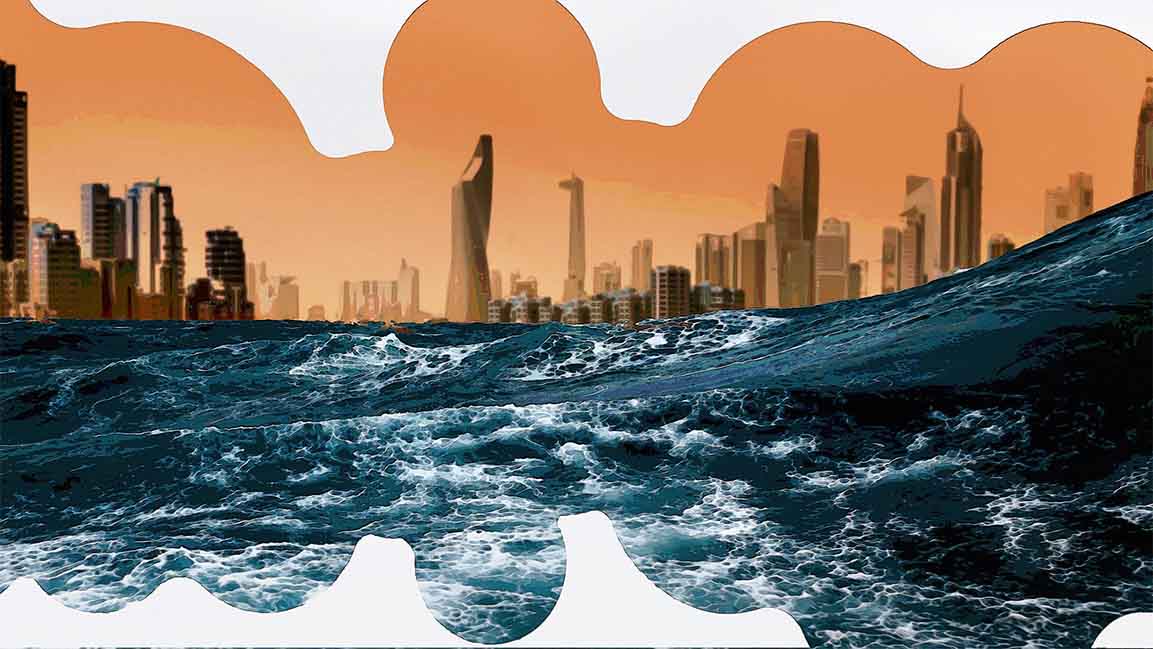- | 9:00 am
Kuwait is facing the challenge of rising sea levels. How can it adapt and overcome?
Sea level rise can render homes, buildings, and roads unusable and create social and economic instability, say experts

The climate and the oceans have warmed beyond the point of no return. By the middle of the century, by one estimate, 800 million people will live in cities where the sea level could rise by more than half a meter. Many coastal neighborhoods already regularly flood.
Being a coastal country at a low elevation, Kuwait is considered at high risk of Sea Level Rise (SLR). Around four-and-a-half million people reside on around 10% of Kuwait’s total land area, a few kilometers from the coastline.
“Kuwait is prone to rising sea levels, particularly the islands. Warba and most of the Boubyan Islands already get flooded at high tides. Other parts would also be at risk of rising sea levels,” says Dr. Bassam Shuhaibar, Program Manager of the Coastal Management Program at the Environmental and Life Sciences Research Center in Kuwait.
Owing to coastal zone rules, a certain width of the coastal land from a high water line (set back distance) is not permitted for any development activity in many nations worldwide — it is a barrier to prevent the sea from advancing into the beach. However, such regulations aren’t yet enforced in Kuwait. A sizable portion of the coastline near the high tide mark has many buildings, including hotels and beach cottages.
According to Dr. Shuhaibar, the Kuwait Institute for Scientific Research (KISR) recently installed a sea-level rise monitoring station, generating data and providing a more accurate picture.
HIGHLY VULNERABLE TO SEA LEVEL RISE
Research authored by Dr. S. Neelamani, a senior research scientist, and four other research scientists at KISR found that 12% of the coastal area is highly vulnerable to SLR. The findings will help develop the Kuwaiti coast’s Integrated Coastal Zone Management plan and long-term coastal infrastructure development to reduce the coastal vulnerability.
Kuwait’s coastal zone is rich in biodiversity. For instance, salt marshes unique to Arab coastland (also known as Subkhas) run along Kuwait’s northern shore and are considered an ecotone between the terrestrial and marine habitats. It is a productive ecosystem that supports a variety of plant species and other creatures.
Referring to the damage caused to salt marshes and coastal lagoons unique to Kuwait’s coast, Dr. Shuhaibar says, “The main impacts will be in the form of salt intrusion and erosion. More seawater means more salt, encroaching on the ecosystems and perhaps even the water table if it is shallow enough. The increase in volume will also mean more beaches get eroded, taking the sediments and whatever was present there.”
He adds that salt marshes would be affected because they require a flooded habitat and then be drained with saltwater by the tides. “If more water is present, that drainage becomes more haphazard, threatening their existence.”
Apart from being an ecological concern, this would harm the shoreline because salt marshes operate as a natural barrier to storm surges and erosion, acting as a natural “shock absorber” — similar to the springs in a car that makes traveling over a speed bump seem much smoother.
In the Kuwait National Adaptation Plan 2019-2030 report published by UN Framework Convention on Climate Change, the coastal vulnerability index was calculated, and the possible inundation percentage was simulated. The calculations concluded that different areas would be impacted differently, but most shorelines are at high risk of inundation.
HARM TO CRITICAL INFRASTRUCTURE
Furthermore, people in the middle and southern coasts are most vulnerable to the SLR impact. These areas are home to vital infrastructure and public services, such as hospitals and educational institutions. According to the KNAP, sea level rise will harm Kuwait’s critical infrastructure and private properties along the coast and disrupt coastal ecosystems.
The societal impacts of sea level rise will be immense as well.
“The potential rise in sea level could have deleterious impacts on Kuwait’s environment and society,” reiterates Dr. Nawaf Almutairi, Professor at the Environmental Sciences Department of the Damietta University of Egypt, who authored a scientific research paper titled Environmental and economic impacts of sea levels: A case study in Kuwait’s coastal zone.
Emphasizing the significance of the governorates making the required adjustments to combat the detrimental effects of SLR, Dr. Almutairi says, “Most of the people reside in areas that are directly exposed to seawater. If the sea level increases due to global warming, these people will have to abandon their homes and move to higher ground.”
The governorates most affected will be Hawalli and Kuwait Capital, which can create social instability as these areas are already heavily populated. Additionally, Kuwait risks losing 49.87 kilometers-307.24 kilometers of its mainland due to SLR.
According to the study conducted by Dr. Almutairi, Kuwait is at risk of suffering substantial economic losses. “In terms of economic impact, the residential sector can face losses ranging from $3.5 billion to $11.1 billion by 2100.”
“However, these estimates will likely be underestimated due to storm surges, price inflation, population growth, and urbanization, which can exacerbate damages. The losses could extend to refineries and oil production facilities, the most important sectors,” he adds.
DESIGN FOR ADAPTATION
Adaptation efforts and rebuilding doesn’t have to happen all at once, but planning a radical response is crucial. To mitigate the effects of SLR, Kuwait’s coastal zones require a well-planned and proactive adaptation approach, says Dr. Almutairi.
“The potential adaptive responses to SLR include relocating buildings and other structures away from vulnerable zones, raising coastal structures above the likely future sea levels, and protecting the coastline through hardened defenses, such as dykes and sea walls, or soft defenses, such as beach nourishment,”
According to Dr. Shuhaibar, Kuwait’s overall infrastructure already provides some “concrete barriers” in the form of buildings and ports. “This would minimize the impact, as would raising the sea walls and other artificial barriers already in place to mitigate this phenomenon.”
Experts say raising public awareness of the possible implications of SLR is essential for improving people’s understanding of the problem and supporting future research and adaptive actions.








































